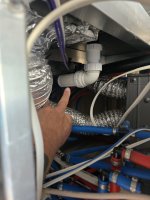we have a 2024 Avenue 32 RLS and I was underneath the storage compartment and removed the access panel and noticed that the drain from the shower does not have a p-trap. it is just a direct drain that goes down and to the left into the holding tank. not being a plumber or knowing what code is but I have done some repairs. doesn't this thing need a p-trap connected there to prevent sewer gases or smells coming from the holding tanks? would like some other input. if this is the case and it does need one I will be contacting Alliance. just trying to get everyone else's thoughts. thanks for everybody's help
You are using an out of date browser. It may not display this or other websites correctly.
You should upgrade or use an alternative browser.
You should upgrade or use an alternative browser.
shower drain
- Thread starter SKYSKIOC
- Start date
BryanValRox
Well-known member
This drain is normally equipped with a membrane bladder style p trap. You should see a fitting that is straight and a bit larger then the actual pipe. It would normally slip on the pipe and than use locking (screw style)compression style ends to lock and seal the plumbing. It needs to be removable to service the bladder should it become stuck open with hair etc from the shower.we have a 2024 Avenue 32 RLS and I was underneath the storage compartment and removed the access panel and noticed that the drain from the shower does not have a p-trap. it is just a direct drain that goes down and to the left into the holding tank. not being a plumber or knowing what code is but I have done some repairs. doesn't this thing need a p-trap connected there to prevent sewer gases or smells coming from the holding tanks? would like some other input. if this is the case and it does need one I will be contacting Alliance. just trying to get everyone else's thoughts. thanks for everybody's help
I'm sure it has a waterless p-trap installed. You can Google it and see how they work. I know both of my washer locations on our Valor use them.
Here is a pic of the waterless p-trap on my shower.
Attachments
Me either and exactly the reason why I really enjoy forums like this.yep confirmed. that is what we have here. I have never seen one of those before or heard of that but now I have been educated. thanks everyone for their input
Edit:
Actually really simple design. This is what AI says about it.
A waterless P-trap, also known as a dry trap, works differently than a traditional water-filled P-trap. Instead of relying on a standing pool of water to block sewer gases, a waterless P-trap uses a mechanical or physical barrier (such as a membrane or a one-way valve) to prevent sewer gases from backing up into the living space.
How a Waterless P-Trap Works
There are a few designs, but most fall into one of these categories:
- Mechanical Sealing Mechanism (e.g., HepvO valve):
- Uses a silicone rubber membrane or flap that opens under water flow pressure and seals shut when flow stops.
- The membrane prevents gases, pests, and odors from traveling back up the pipe.
- Ball or Float Valves:
- A lightweight ball sits in the trap body and seals the drain unless displaced by water flow.
- Flexible diaphragm or self-sealing valve:
- Acts like a one-way check valve; opens to let wastewater pass, then closes to block air/gas return.
Advantages
- No risk of trap seal evaporation (common in infrequently used fixtures).
- Can be installed in tight or unvented spaces (ideal for RVs, basements, or island sinks).
- Resistant to freezing, since there's no standing water to expand.
Waterless P-traps require less frequent maintenance than traditional ones, but there are a few important steps to keep them working:
| Maintenance Task | Description |
| Periodic Inspection | Check the valve/membrane every 6–12 months for debris, wear, or sticking. |
| Cleaning | Remove and rinse the valve to clear hair, soap scum, or other buildup if drainage slows. |
| Replace When Needed | Silicone membranes or valve assemblies may degrade over time—typically 3–5 years. |
| Seal Check | Make sure the trap closes properly to block odors. If you notice a sewer smell, it may be due to a failing seal or stuck valve. |
| Use as Intended | Avoid harsh chemicals or drain snakes that might damage the membrane or mechanism. |
Last edited:
BryanValRox
Well-known member
Do forget to consider the impact of @ 300 lbs to your pin weight and tow vehicle.excellent advice. we are looking into a washer dryer combo ventless for our 32 RLS
Midnight Rider
Well-known member
T
Combo units take forever to dry a small amount of close and leave your close a wrinkled mess.
Those combo units are not great in my opinion? I recommend separate units or use rv laundry mat.excellent advice. we are looking into a washer dryer combo ventless for our 32 RLS
Combo units take forever to dry a small amount of close and leave your close a wrinkled mess.


